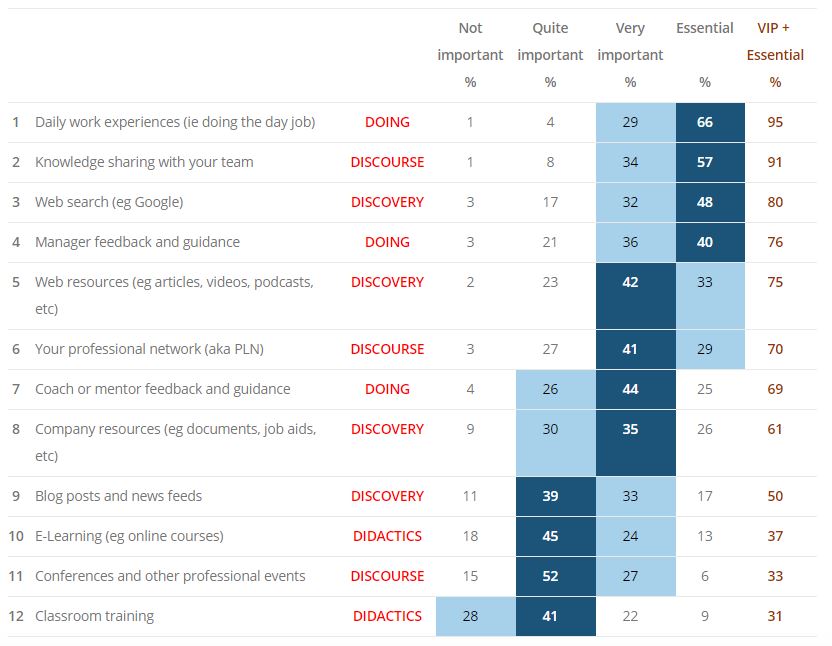Interpreting the results of the latest Learning in the Workplace Survey
What does the Learning in the Workplace Survey actually tell us?

The Learning in the Workplace Annual Survey is now in its seventh year and has now had over 6,000 responses from 69 countries worldwide. The latest results are summarised in the table below:

The Centre for Modern Workplace Learning, publishers of the study, offers the following commentary and conclusions of the study results:
The 5 most valued ways of learning at, for or through work, are Daily work experiences, Knowledge sharing with teams as well as Web resources, Web search and Professional Networks and Communities. These are, in fact, all self-organised (and self-managed) forms of learning.
Whereas, traditional organised learning initiatives like Classroom training and E-Learning sit right at the bottom of the list along with Conferences and other events. Feedback and guidance from managers and coaches, as well as internal resources fall squarely in the middle of the results.
What do the survey authors infer this means?
It means that most of L&D efforts are focused on activities that individuals find of little value.
It means it is therefore time to re-focus efforts on those activities that bring more value to individuals – both inside and outside the workplace.
But it doesn’t mean organising and managing these activities (in the old, traditional ways) but helping individuals to do this for themselves in the ways that suit them best.
It means a new model for modern workplace learning.
But is this ‘the whole truth, and nothing but the truth’?
I am reminded of the now well-established 70/20/10 model for modern workplace learning. The 70/20/10 learning model was first developed by the Centre for Creative Leadership (CCL) and has gained much momentum and support in recent years. The 70:20:10 model recognises that effective learning comprises of experiential, social and formal learning, but not in equal measure. Formal learning is represented as the ratio 10 in the model and indicates its subservience to experiential (70) and social (20) settings. But don’t be fooled into thinking that formal learning is therefore of little value or significance; rather, consider it as a necessary precursor to an effective experiential and social learning setting. The message is simple ‘we learn best through personal experience and endeavour when supported by trusted experts and some foundational knowledge of the subject area’. Advocates of 70/20/10 advise us not to get hung up by the absolute numbers but more to note the relative proportions and recognise that structured learning, whether it be in the classroom or through digital courses, should only ever play a relatively minor role in the fullness of an effective learning strategy.
70/20/10 seeks to recognise the full extent of the learner journey and its rapid rise in popularity and acceptance in the workplace learning community suggests it resonates well with current professional views.
I would therefore suggest that the results of the Learning in the Workplace survey are by no means surprising or alarming and are totally aligned to a community of learners that view their learning through the lens of 70/20/10. The highest profile of learning opportunities for them are those that are playing to the 70 and the 20 and this corresponds to those at the top of the survey ranking which are the experiential and collaborative ways of learning.
I don’t disagree with the conclusions drawn by the Centre for Modern Workplace Learning but I don’t believe they yet tell ‘the whole truth’ and there is a danger of ‘throwing out the baby with the bath water’ if the whole truth is not considered more fully.
Tony Small, June 2019

